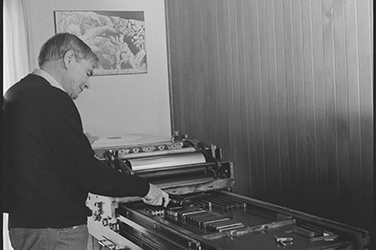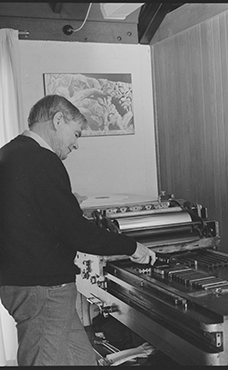- Free Article: No
- Contents Category: Commentary
- Custom Article Title: ‘Too many slips showing’: Alec Bolton and Australian Book Review
- Review Article: Yes
- Article Title: ‘Too many slips showing’
- Article Subtitle: Alec Bolton and Australian Book Review
- Online Only: No
- Custom Highlight Text:
When I began work on A Maker of Books, I had no idea that Alec Bolton had succeeded ‘Peter Pica’ (the publisher and bookseller Andrew Fabinyi) as a pseudonymous critic of Australian book design and production for Australian Book Review. He called himself ‘Martin Em’. I had set out to explore in detail Alec’s achievement as a letterpress printer of distinction at his private Brindabella Press, and also his long career in Australian publishing, but this was an unexpected discovery. The clue was a letter from Alec to John McLaren, the then editor of ABR, which I found in a completely unrelated file in the Alec Bolton papers at the National Library of Australia. When I looked at Martin Em’s ‘BookShapes’ columns, published between 1978 and 1982, Alec’s distinctive voice was quite apparent.
- Featured Image (400px * 250px):

- Alt Tag (Featured Image): Michael Richards on Alec Bolton and Australian Book Review
The author appears to be emphasising numerous lines and even paragraphs by the use of bold type; but then we realise that these are photoset correction lines that have emerged from the processor with a heavier density but which have been stripped in regardless. The two lines of the centred title are not quite centred, and for that matter not parallel either. Page numbers … wander nervously in and out of the margins … A portrait drawing on the front of the jacket is repeated in reverse on the back, as if left and right were all the same to this subject. What we infer from this book is that nobody in the publisher’s office could have cared for it. There is no worse fate.
On the other hand, he praised books designed with ‘generous pages and a confident use of white space; illustrations and text working together without strain’ and books printed with good judgement in both leading and typeface selection.
Martin Em’s comments are well worth revisiting. They also reveal much about Alec Bolton’s ambitions at his Brindabella Press, the private press which is the main focus of my attention in A Maker of Books. Of one book reviewed in 1979, he commented that ‘It is typical of so many books that we see today, where different hands have clearly been at work on different parts of the job. For my part I like books that are coherent and all-of-a-piece.’ ‘The Australian book is by and large a good-looking piece of merchandise,’ he wrote a little later. ‘Sophistication and confidence have advanced hand in hand and taken Australian publishing over. However, some books that I have looked at closely have proved disappointing in points of detail. It seems that the abundant skill which is at work in making books is often hard-pressed by the need for high productivity. Too little time; too many slips showing.’
While he could be just as critical of his own shortcomings as a printer, many of the books he designed and printed by hand with painstaking care and attention to detail at the Brindabella Press stand out as some of the most attractive Australian books of the era. So too do the books published by Alec during his day job, as the founding publisher at the National Library of Australia. Both the books of the Brindabella Press and the NLA titles of that era continue to deserve close attention from publishers, printers, and readers today.
Alec Bolton’s columns (under the nom de plume Martin Em) are all available in ABR’s digital archive.



Comments powered by CComment